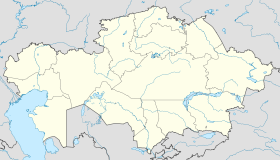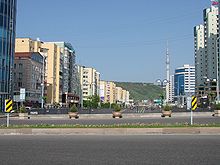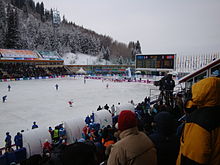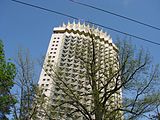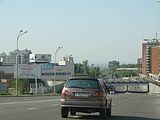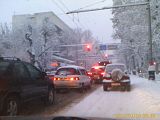
Almaty
About this schools Wikipedia selection
SOS Children offer a complete download of this selection for schools for use on schools intranets. Click here for more information on SOS Children.
| Almaty Kazakh: Алматы |
|||
|---|---|---|---|
|
|||
|
|
|||
| Coordinates: 43°16′39″N 76°53′45″E Coordinates: 43°16′39″N 76°53′45″E | |||
| Country | Kazakhstan | ||
| Province | Almaty | ||
| First settled | 10–9th century BC | ||
| Founded | 1854 | ||
| Incorporated (city) | 1867 | ||
| Government | |||
| • Akim (mayor) | Akhmetzhan Yesimov | ||
| Area | |||
| • Total | 324.8 km2 (125.4 sq mi) | ||
| Elevation | 500–1,700 m (1,640–5,577 ft) | ||
| Population (1 December 2012) | |||
| • Total | 1,472,866 | ||
| • Density | 4,535/km2 (11,750/sq mi) | ||
| Time zone | UTC+6 ( UTC+6) | ||
| Postal code | 050000–050063 | ||
| Area code(s) | +7 727 | ||
| ISO 3166-2 | ALA | ||
| License plate | A | ||
| Website | http://www.almaty.kz | ||
Almaty ( Kazakh: Алматы / Almatı, i.e. "father of apples" or "father of apple trees") is the former capital of Kazakhstan and the nation's largest city, with a population of 1,472,866 (at 1 December 2012). This represents approximately 9% of the country's population.
Almaty was the capital of the Kazakh SSR from 1929 to 1991 and of independent Kazakhstan from 1991 to 1997. Despite losing its status as the capital to Astana in 1997, Almaty remains the major commercial and cultural centre of Kazakhstan. The city is located in the mountainous area of southern Kazakhstan, near the border with Kyrgyzstan.
Status
From 1927 to 1936, Almaty was the capital of Kazakh ASSR. From 1936 to 1991, it was the capital of Kazakh SSR, and from 1991 to 1997, it was the capital of Kazakhstan. Almaty remains the largest, most developed, and most ethnically and culturally diverse city in Kazakhstan. The city is located in the foothills of Trans-Ili Alatau (or Zailiysky Alatau) in the extreme south-east and has a relatively mild climate with warm summers and quite cold winters. Since the city is located in a tectonically active area, there is a constant possibility of earthquakes. Although most of them do not represent any significant danger or cause damage, historically Almaty does have a record of some large destructive earthquakes.
In 1997, the capital was moved to Astana. Since then, Almaty has been referred to as the southern capital of Kazakhstan.
Toponymy
The name Almaty has its roots in medieval settlement Almatu, that existed near the present-day city.[[fact}}
There is a theory, which is disputed, that the city derives its name from the Kazakh word for 'apple' (алма), and thus is often translated as "full of apples;" alma is also 'apple' in other Turkic languages, as well as in Hungarian and Mongolian. The Russian version of its name - Alma-Ata, used during Soviet-era - was often perceived by as a combination of two Kazakh words, meaning Father of Apples.
There is great genetic diversity among the wild apples in the region surrounding Almaty; the region is thought to be the ancestral home of the apple, and the wild Malus sieversii is considered a likely candidate for the ancestor of the modern domestic apple, which could explain the "Alma Ata" name. The area is often visited by researchers and scientists from around the world in order to learn more about the complex system of genetics, and also to discover the true origin of the domestic apple.
History
Prehistoric Almaty
During 1000–900 BC in the Bronze Age the first farmers and cattle-breeders established settlements on the territory of Almaty.
During the Saka’s period (from 700 BC to the beginning of the Common Era), these lands were chosen for residence by Saka tribes and later Uisun tribes inhabiting the territory north of the Tian Shan mountain range. The evidences of these times are numerous burial tumuli and ancient settlements, especially giant burial mounds of Saka tsars. The most famous archaeological finds are the Golden man from the Issyk Kurgan, Zhalauly treasure, Kargaly diadem, Zhetysu arts bronze (boilers, lamps and altars). During the period of Saka and uisun governance, Almaty became the early education centre.
Middle Ages
The next stage of Almaty evolution is attributed to the Middle Ages (8–10th centuries) and is characterized by city culture development, transfer to a settled way of living, farming and handicraft development, and the emergence of a number of towns and cities in the territory of Zhetysu.
In the 10–14th centuries, settlements in the territory of the so-called "Big Almaty" became part of the trade routes of the Silk Road. At that time, Almaty became one of the trade, craft and agricultural centers on the Silk Road and possessed an official mint. The city was first mentioned as Almatu in books from the 13th century.
15th–18th centuries
In the 15th–18th centuries, the city was on the way to degradation as trade activities were decreasing on this part of the Silk Road. Notwithstanding, this period was saturated with very important political events that had significant impact on the history of Almaty and Kazakhstan as a whole. It was a period of crucial ethnic and political transformations. The Kazakh state and nation were founded here, close to Almaty.
These lands also witnessed the tragic developments related to the Dzungar intervention and rigorous efforts of the Kazakh to protect their land and preserve independence. In 1730 the Kazakh defeated the Dzungar in the Anyrakay mountains, 70 km to north-west from Almaty. It was a critical moment of the Patriotic War between Kazakhs and Dzungars. It was later part of Khanate of Kokand before Russian conquest in 1854.
Foundation of Verniy
On 4 February 1854 the modern history of the city began with the strengthening of the Russian piedmont Fort Verniy nearby the Zailiysky Alatau mountain range between Bolshaya and Malenkaya Almatinka rivers. The construction of the Verniy Fort was almost finished by autumn 1854. It was a fenced pentagon and one of its sides was built along the Malaya Almatinka. Later, wood fence was replaced with the wall of brick with embrasures. Main facilities were erected around the big square for training and parading.
In 1855 the first displaced Kazakh appeared in Verniy. Since 1856, Verniy started accepting Russian peasants. They founded the Bolshaya Almatinskaya Stanitsa ( Cossack village) nearby the fortification. The inflow of migrants was increasing and led to construction of the Malaya Almatinskaya Stanitsa and Tatarskaya (Tashkentskaya) sloboda. It was the place of settlement for Tatar merchants and craftsmen.
In 1867 the Verniy Fort was transformed into the town and called Almatinsk. However, the population did not like the new name of the town and soon the town was renamed as Verniy.
According to the First City Plan, the city perimeters were 2 km on the south along Almatinka river, and 3 km on the west. The new city area was divided into residential parts, and the latter – into districts. Three categories of the city buildings were distinguished. Buildings of the first and second categories were two-storied or, at least, one-storied constructions with the high semi-basement. Buildings of categories I and II were erected around and in the centre of the city, others – on the outskirts.
On 28 May 1887, at 4 a.m., an earthquake almost totally destroyed Verniy in 11–12 minutes. Brick buildings were mostly damaged. As a result, people were inclined to build up one-storied construction made of wood or adobe.
Soviet Era
In 1918, Verniy established Soviet power. The city with the region became part of the Turkestan autonomy in the RSFSR.
On 5 February 1921 it was decided to rename Verniy to Alma-Ata, which was one of the ancient names of the area: Almaty – "apple."
On 3 April 1927 the capital of Kazak ASSR moved from Kyzylorda to Alma-Ata, within the RSFSR. This was an additional impetus for intensive development. From 1936 (since the formation of the Kazakh SSR), Alma-Ata was the capital of the first Kazakh SSR, and then it used to be a capital of an independent Kazakhstan.
Industrialization in the Soviet period
After 1941, due to the mass evacuation of factories and workers from the European part of Soviet Union during World War II, Alma-Ata of administrative and trading centre with a border-security destination and an underdeveloped industry has become one of the largest industrial centers of the Soviet Union. A special role in this process was played by the location of the city, which was in the rearward. During the years 1941–1945 the industrial potential of the city has increased significantly. The economically active population of the city has grown from 104 thousand in 1919 to 365,000 in 1968. In 1967 the city had 145 enterprises, with the bulk of their weight – light and food industry, which is slightly different from a typical Soviet city bias towards heavy industry and capital goods production. The main industries are food processing (36% of gross industrial output), based largely on local abundant fruit and vegetable raw materials, and light industry (31%). The main plants and the food industry: Meat, flour and cereals (pasta with a factory), milk, sparkling wines, canned fruit, tobacco factories, confectionery, distillery plants, wine, brewery, yeast, tea-packing factory, light industry, textile and fur mills, factories, cotton spinning, knitting, carpets, footwear, apparel, printing and an Almaty Cotton combine. Heavy industry accounted for 33% of the production was presented by the enterprises of heavy engineering, electrical engineering there are factories, foundry and engineering, car repair, repair bearing, building materials, woodworking, concrete structures and structural elements, house-building.
Revolution of 1917 to World War II
In 1921, a joint consultation was summoned of regional government representatives, professional trade associations, and local faith-based groups in an effort to rename Verniy. Alma-Ata was the preferred choice.
In 1926, the Council of Labor and Defense approved the construction of the Turkestan-Siberia Railway that was a crucial element of the future growth of Kazakhstan, especially on the east and southeast of the region. The Turkestan-Siberia Railway construction also had a decisive economic impact that strongly influenced the destiny of Alma-Ata as the capital of Kazakh ASSR. In 1930 the construction of the highway and railway to Alma-Ata was completed.
On 29 April 1927, it was officially decided to transfer the capital of the Kazakh Autonomous Soviet Socialist Republic from Kyzyl-Orda to Alma-Ata.
The Alma-Ata airport was opened in 1930, opening up a direct connection from Alma-Ata to Moscow. Alma-Ata became the main entryway by air to Kazakhstan, a status which it retains today. Transformation of ths small town into the capital of the Kazakh SSR was accelerated by the large-scaled construction of new administrative and government facilities and housing.
During the transfer of capital status from Kyzyl-Orda to Alma-Ata, a 1936 plan by the Architecture and Planning Bureau aimed to remodel Alma-Ata as the new cultural capital of the Kazakh SSR. The plan was based on the existing rectangular system of districts that would further be strengthened and reconstructed.
World War II
During World War II the city's territory was reshuffled quite dramatically. To better organize the home front and concentrate industrial and material resources, the residential areas were compressed to arrange accommodation for 26,000 people evacuated from the European theatre of war. Alma-Ata hosted over 30 industrial facilities removed from the European section of the USSR, 8 evacuated hospitals, 15 institutes, universities and technical schools, and around 20 cultural institutions. Motion picture production companies from Leningrad, Kiev, and Moscow were also moved to Alma-Ata at this time.
Over 52,000 Alma-Ata residents received the title: Gratefulness for Your Self-Denying Labor. 48 residents were granted the title of Hero of The Soviet Union. Three rifle divisions were raised in Alma-Ata, including the well-known 8th Guards Rifle Division ' Panfilov' (originally the 316th rifle division), along with 2 rifle battalions and 3 aviation regiments that were raised on the bases of the air club of Alma-Ata.
1945 to 2000
From 1966 to 1971, 1,400,000 square meters of public and cooperative housing were built. Annually, around 300,000 square meters of dwellings were under construction, and most of the buildings made during this time were earthquake-proof multistory buildings. Furthermore, construction unification and type-design practice diversified architectural forms, leading to a more varied cityscape. During this period, lots of schools, hospitals, cultural and entertainment facilities were constructed, including Lenin’s Palace, Kazakhstan Hotel, and the “ Medeo” sports complex.
The Medeu Dam, designed to protect the city of Almaty and the Medeo skating rink from catastrophic mudflows, was built in 1966 and reinforced a number of times in the 1960s and 1970s.
The supersonic transport Tupolev Tu-144 went into service on 26 December 1975, carrying mail and freight between Moscow and Alma-Ata in preparation for passenger services, which began in November 1977. The Aeroflot flight on 1 June 1978 was the 55th and last scheduled passenger flight of the Tu-144.
Since 1981, the subway Almaty Metro construction project has been in construction.
On 16 December 1986 Jeltoqsan riot took place in response to General Secretary Mikhail Gorbachev's dismissal of Dinmukhamed Kunayev.
In 1993 the government made a decision to rename Alma-Ata. The new name of the city is Almaty.
In 1997 the President of the Republic of Kazakhstan Nursultan Nazarbayev approved the Decree to transfer the capital from Almaty to Astana.
On 1 July 1998 a law was passed concerning the special status of Almaty as a scientific, cultural, historical, financial, and industrial centre.
21st century
The new 2030 General Plan of Almaty was developed in 1998 and aims at forming ecologically safe, secure and socially comfortable living conditions. The main objective is to promote Almaty’s image as a garden-city. One of the components of the General Plan is to continue multi-storied and individual construction, reorganize industrial territories, improve transport infrastructure and expand Almaty Metro. The first line of Almaty metro was launched on December 1, 2011, two weeks ahead of schedule. The extension of the line to Kalkaman is currently under construction and is planned to open in 2015. The area of the city has been expanded during recent years with the suburban settlements of Kalkaman, Kok Tube, Gorniy Gigant (Mountain Giant) being added to the city. Numerous apartment blocks, and office skyscrapers have transformed the face of the town, which climbs higher and higher up the mountains.
Climate
The climate in Almaty is a humid continental climate with very warm summers and cold winters. It is characterized by the influence of mountain-valley circulation, which is especially evident in the northern part of the city, located directly in the transition zone of the mountain slopes to the plains.
Annual average air temperature is equal to 10 °C (50 °F), the coldest month is January, −4.7 °C (24 °F) (on average), the warmest month (July) 23.8 °C (75 °F) (on average). In average years frost starts on about 14 October and ends on about 18 April, with sustained extreme cold from about 19 December to about 23 February, a period of about 67 days. Weather with temperature above 30 °C (86 °F) is average for about 36 days a year. In the centre of Almaty, like any large city, there is a "heat island" – average daily temperature contrast between the northern and southern suburbs of the city is 3.8% and 0.8 °C (33.4 °F) in the coldest and 2.2% and 2.6 °C (36.7 °F) in the hottest five days. Therefore, frost in the city centre starts about 7 days later and finishes 3 days earlier than in the northern suburbs. Annual precipitation is about 650 to 700 mm (25.6 to 27.6 in). April and May are the wettest months, during which about a third of the city’s annual precipitation is received. Average date of the formation of stable snow is 30 October, though its appearance varies from 5 October until 21 November. The average date of snowmelt is 2 April (ranging from 26 February to 12 May). The city and its suburbs have fog for about 50–70 days annually.
It is not uncommon for snow and a cold snap to hit Almaty as late as the end of May. For example in the last quarter century, such snowfalls were recorded on 13 May 1985, 1 May 1989, 5 May 1993 and 18 May 1998. The record latest snowfall in Almaty was on 17 June 1987.
Almaty sometimes experiences winter rain, despite heavy preceding snowfall and low temperatures. The most memorable winter rain took place at 16 December 1996 during a military parade to celebrate the 5th anniversary of the Independence of the Republic.
Almaty Weather Station’s GM mostly records south-easterly wind (30%), its resistance increases during the summer (37%) and falls in winter (19%). Wind speeds exceed 15 m/s on about 15 days a year, on average.
| Climate data for Almaty | |||||||||||||
|---|---|---|---|---|---|---|---|---|---|---|---|---|---|
| Month | Jan | Feb | Mar | Apr | May | Jun | Jul | Aug | Sep | Oct | Nov | Dec | Year |
| Record high °C (°F) | 18.2 (64.8) |
19.0 (66.2) |
28.0 (82.4) |
33.2 (91.8) |
35.1 (95.2) |
39.3 (102.7) |
43.4 (110.1) |
40.5 (104.9) |
38.1 (100.6) |
31.1 (88) |
25.4 (77.7) |
19.2 (66.6) |
43.4 (110.1) |
| Average high °C (°F) | 0.7 (33.3) |
2.2 (36) |
8.7 (47.7) |
17.3 (63.1) |
22.4 (72.3) |
27.5 (81.5) |
30.0 (86) |
29.4 (84.9) |
24.2 (75.6) |
16.3 (61.3) |
8.2 (46.8) |
2.3 (36.1) |
15.8 (60.4) |
| Daily mean °C (°F) | −4.7 (23.5) |
−3.0 (26.6) |
3.4 (38.1) |
11.5 (52.7) |
16.6 (61.9) |
21.6 (70.9) |
23.8 (74.8) |
23.0 (73.4) |
17.6 (63.7) |
9.9 (49.8) |
2.7 (36.9) |
−2.8 (27) |
10.0 (50) |
| Average low °C (°F) | −8.4 (16.9) |
−6.9 (19.6) |
−1.1 (30) |
5.9 (42.6) |
11.0 (51.8) |
15.8 (60.4) |
18.0 (64.4) |
16.9 (62.4) |
11.5 (52.7) |
4.6 (40.3) |
−1.3 (29.7) |
−6.4 (20.5) |
5.0 (41) |
| Record low °C (°F) | −30.1 (−22.2) |
−37.7 (−35.9) |
−24.8 (−12.6) |
−10.9 (12.4) |
−7.0 (19.4) |
2.0 (35.6) |
7.3 (45.1) |
4.7 (40.5) |
−3.0 (26.6) |
−11.9 (10.6) |
−34.1 (−29.4) |
−31.8 (−25.2) |
−37.7 (−35.9) |
| Precipitation mm (inches) | 34 (1.34) |
43 (1.69) |
75 (2.95) |
107 (4.21) |
106 (4.17) |
57 (2.24) |
47 (1.85) |
30 (1.18) |
27 (1.06) |
60 (2.36) |
56 (2.2) |
42 (1.65) |
684 (26.93) |
| Avg. precipitation days (≥ 1.0 mm) | 5.8 | 6.1 | 9.5 | 9.6 | 9.9 | 7.3 | 5.3 | 3.5 | 3.6 | 6.5 | 6.5 | 5.7 | 79.3 |
| % humidity | 77 | 76 | 71 | 59 | 56 | 49 | 46 | 45 | 49 | 64 | 74 | 79 | 62 |
| Mean monthly sunshine hours | 117.8 | 118.7 | 145.7 | 195.0 | 241.8 | 279.0 | 306.9 | 294.5 | 246.0 | 182.9 | 126.0 | 102.3 | 2,356.6 |
| Source #1: Pogoda.ru.net | |||||||||||||
| Source #2: Hong Kong Observatory (sun and precipitation days) | |||||||||||||
Seismicity of the territory of Kazakhstan
Industrially developed and densely populated areas in the south and southeast of Kazakhstan are situated in the zones with maximum magnitudes of the expected earthquakes equaled from 6.0 to 8.3 (the intensity of I0=8–10).
South seismic active zone of Kazakhstan is a part of the North Tian-Shan ridge system. The main city of Almaty is located near the Zailiski Alatau mountain base. In recorded history prior to the late Nineteenth century three catastrophic earthquakes are known to have taken place there. The following are the dates of occurrence and extracts from the historical chronicles of the times: 1770, «...lake on the place of Belovodka village was buried up»; 1807, «in Almaty horrible catastrophe took place»; and the third strong earthquake took place in 1865.
Within the past 125 years three more strong destructive earthquakes occurred here, with focuses not more than 20 – 130 kilometers from the current city location. Their magnitudes were 9 and 11 on MSK scale – 64, and their focuses were located within the range of 100 kilometers. Focuses were located in south and south – east directions: Chilik (1889 y., K���=19.12), Vernenskoe (1887 y., K���=17.14) and Keminskoe (1911 y., K���=18.76). K��� – is energetic class of earthquakes. In each of these earthquakes the city was heavily destroyed. (Baimakhan, Dashdorj, 2006).
Territory of Kyrgyz State adjoins North Tian-Shan. (Aitmatov, Kojogulov, Nikolskaya, 1994.).
Demographics
Ethnic groups (2010) Агентство Республики Казахстан по статистике. Архив:
- Kazakh: 51.06%
- Russian: 33.02%
- Uyghur: 5.73%
- Korean: 1.9%
- Tatar: 1.82%
- Ukrainian: 1.24%
- Others: 5.23%
According to the USSR Census of 1989, population of Almaty was 1,071,900; Kazakhstan Census of 1999 reported 1,129,400.
Economy
Almaty generates approximately 20 per cent of Kazakhstan's GDP(or $36 billion in 2010); Almaty is a key financial centre in Central Asia and is considered to be a Gamma Global City
One of the largest industries in Almaty is finance, and its financial exports make it a large contributor to the Kazakhstan's balance of payments. Almaty is home to the BTA Bank, which is the largest bank in Central Asia, Kaz Kom Bank and other major banks. The Kazakhstan Stock Exchange is based in Almaty.
Almaty is also developing as the regional financial and business centre – RFCA..
Currently under construction is 'Almaty Financial District and Esentai Park'. This was designed by T.J. Gottesdiener, who designed 7 World Trade Centre in New York City, Time Warner Centre in New York City and Tokyo Midtown. Its publicised aim is to become the largest business centre in Central Asia. Esentai Tower, a 37 floors building in the park, is the tallest mixed-use building in Kazakhstan and lodges offices of companies such as Ernst & Young, HSBC and Credit Suisse. The first Ritz-Carlton Hotel in Kazakhstan will open by the end of 2013 in Esentai Tower.
Along with professional services, media companies are concentrated in Almaty as well. The media distribution industry has been growing rapidly since 2006. Major broadcasting channels KTK and NTK are based in Almaty, as are several national newspapers.
There are plans to construct a Western Europe-Western China highway, passing through Almaty. A new port in Almaty expects to handle about 45 million tonnes of cargo each year.
Air Astana is headquartered in the Air Astana Centre 1 in Almaty. Prior to their dissolution, Air Kazakhstan and Kazakhstan Airlines were also headquartered in Almaty.
Sights
Kök Töbe
An aerial tramway line connects downtown Almaty with a popular recreation area at the top of Kök Töbe ( Kazakh: Көктөбе, which means 'Green Hill'), a mountain just to the southeast. The city television tower, Alma-Ata Tower, is located on the hill, as well as a variety of tourist attractions, such as amusement-park style rides and restaurants.
Fountains
According to the city's Department of Natural Resources and Resource Use Management, as of 2007 the city has 125 fountain groups or isolated fountains. Among them is the "Oriental Calendar" Fountain, whose 12 sculpture figures represent the 12 animals of the Kazakh 12-year animal cycle (similar to its Chinese counterpart).
Education
Universities
- International IT University (IITU)
- Kazakh-British Technical University (KBTU)
- University of International Business
- Kazakh National Medical University
- Almaty Institute of Power Engineering and Telecommunications
- Kazakh-American University
- Kazakh National Technical University (KazNTU)
- Al-Farabi Kazakh National University (KazNU)
- Suleyman Demirel University (SDU)
- KIMEP (Kazakhstan Institute of Management, Economics, and Strategic Research)
- Kazakh-American University (KAU)
- Kazakh National Academy of Arts named by T.Zhurgenov
- Kazakh Academy of Sciences
- Kazakh Academy of Labour and Social Relations
- Kazakh National Pedagogic University(named after Abay)
- Turan University
- Kazakh University of International Relations and World Languages (named after Abylai khan)
- Central Asian University (ЦАУ)
- Kazakh-German University (КНУ)
- Kazakh Leading Academy of Architecture and Civil Engineering
- Kazakh Economic University named after T. Ryskulov (KazEU, Narxoz)
- Kazakh National Agrarian University (SHI, AEZVI)
- International Business Academy
Sports
The historic bandy team Dinamo won the Soviet Championships in 1977 and 1990 and the European Cup in 1978. Their home ground was Medeo, where bandy was the only sport at the 2011 Winter Asian Games. Medeo is the main arena at the 2012 Bandy World Championships. The second arena, built for the championships, is an alternative field of Almaty Central Stadium. Federation of International Bandy has opened an office for Asia, which is located in Almaty.
It is also home to Almaty United Football club.,
Olympic aspirations
Almaty was a bidder to host the XXII Olympic Winter Games in 2014, but was eliminated from consideration, not making the "short list" of candidate cities. Almaty won its bid to host the 2011 Winter Asian Games. It will be the 2017 Winter Universiade host. The city was exploring possible future bids, such as the 2018 Winter Olympics, but did not actually submit a bid.
People from Almaty
- Altynai Asylmuratova (* 1961), prima ballerina with the Kirov ballet
- Eugen Bauder (* 1986), model in Germany
- Alexander Brener (* 1957), film star in Russia
- Nagima Eskalieva (* 1954), singer and entertainer
- Dmitri Fofonov (* 1976), Racing cyclist
- Pavel Gaiduk (* 1976), ski jumper
- Valery Yurlov (* 1933), actor in Russia
- Alexey Korolev (* 1987), ski jumper
- Nikolay Karpenko (* 1981), ski jumper
- Ruslana Korshunova (1987–2008), model in Russia
- Olessya Kulakova (* 1977), volleyball representative for Germany
- Regina Kulikova (* 1989), tennis player
- Dinmukhamed Konayev (1912–1993), politician
- Yelena Lichovzeva (* 1975), tennis player in Russia
- Fuat Mansurov (1928–2008), Soviet and Russian conductor
- Dmitriy Ogai (* 1960), soccer trainer and Soviet soccer player
- Sergei Ostapenko (* 1986), soccer player
- Alexander Parygin (* 1973), olympic athlete
- Alexander Petrenko (1976–2006), basketball representative for Russia
- Dennis Pohl (* 1986), cycle racer in Germany
- Oxana Rakmatulina (* 1976), basketball player in Russia
- Vadim Sayutin (* 1970), ice speed skater in Russia
- Thomas Schertwitis (* 1972), water polo
- Olga Shishigina (* 1968), Olympic Champion in hurdling
- Elena Likhovtseva (* 1975), tennis player
- Susanna Simon (* 1968), actress in Germany
- Assan Tachtachunov (* 1986), ski jumper
- Denis Ten (* 1993), figure skater
- Taimuraz Tigiev (* 1982), wrestler
Yernar Yerimbetov (1980), gymnast
- Anatoly Vaisser (* 1949), French chess grandmaster
- Irina Vygusova (* 1974), diver
- Radik Zhaparov (* 1984), ski jumper
- Vladimir Zhirinovsky (* 1946), politician
- Elena Zoubareva (* 1972), opera singer
- Konstantin Sokolenko (* 1987), Nordic combined skier/ski jumper
- Kalila Umarov (* 1957), film director
- Anatoly Bose (* 1988), Australian basketball player
| Other pictures of Almaty | ||||||||||||||
|
||||||||||||||
Sister cities
| Country | City |
|---|---|
| Tucson | |



